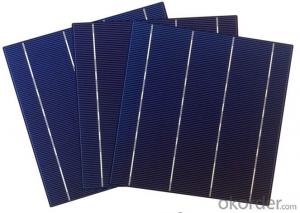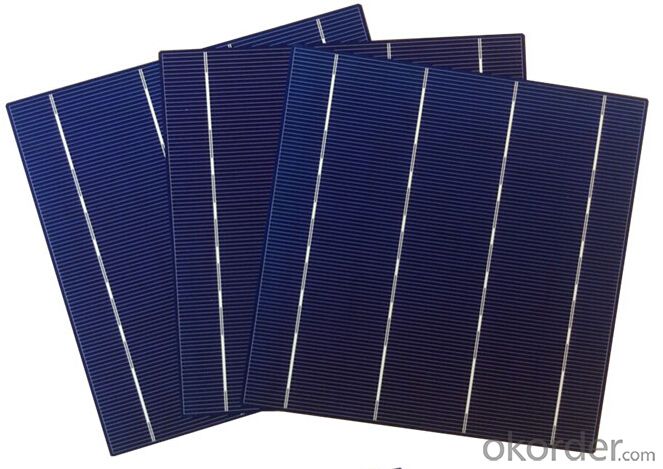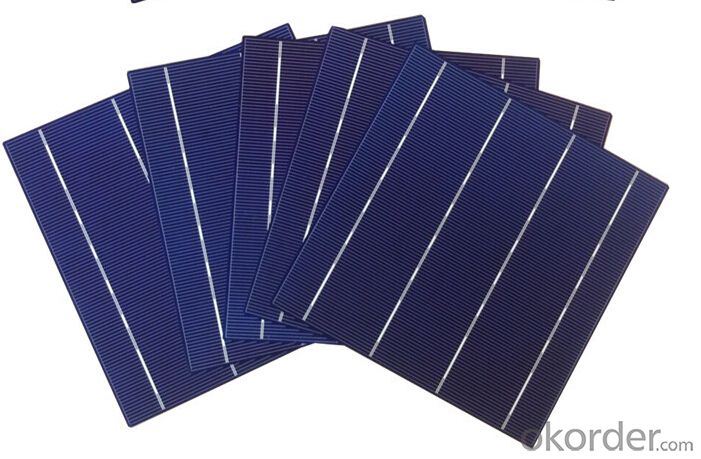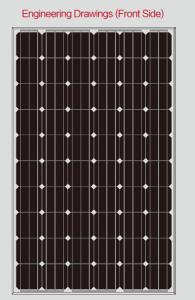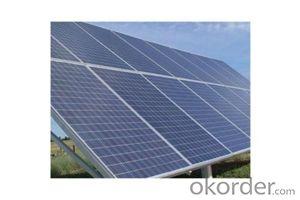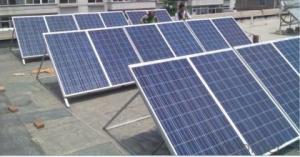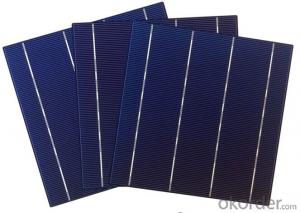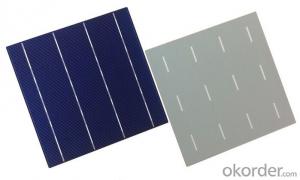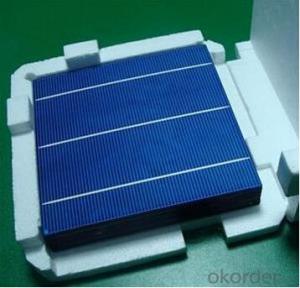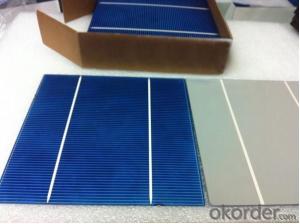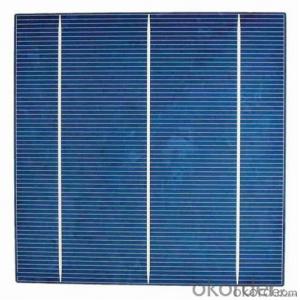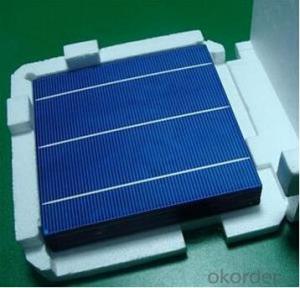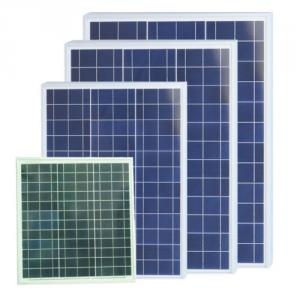Best Solar Panels in Texas:A Grade and B Grade 3BB and 4BB Solar Cells with High Efficiency 19.1%
- Loading Port:
- Shanghai
- Payment Terms:
- TT OR LC
- Min Order Qty:
- 10000 watt
- Supply Capability:
- 100000000 watt/month
OKorder Service Pledge
OKorder Financial Service
You Might Also Like
Specification
1.Product Description:
Specifications of Poly Solar Cells
Dimension | 156mm X 156 mm ±0.5mm |
Wafer Thickness | 200um ±30um |
Front(-) | Four 1.1mm wide bus bars(silver) with distance 39mm, Acid texturized surface with blue silicon nitride AR coating. |
Back(+) | 2.4mm wide silver/aluminum soldering pads, aluminum back surface field. |
Temperature Coefficient of Poly Cells
Voc.Temp .coef.%/K | -0.351%/K |
Isc.Temp .coef.%/K | +0.035%/K |
Pm.Temp. coef.%/K | -0.47%/K |
Electrical Characteristic of Poly Cells
Efficiency code | 1720 | 1740 | 1760 | 1780 | 1820 | 1840 | |
Efficiency (min) | (%) | 17.2 | 17.4 | 17.6 | 17.8 | 18.2 | 18.4 |
Pmax | (W) | 4.186 | 4.234 | 4.283 | 4.332 | 4.429 | 4.478 |
Voc | (V) | 0.631 | 0.632 | 0.634 | 0.636 | 0.640 | 0.642 |
Isc | (A) | 8.446 | 8.485 | 8.523 | 8.573 | 8.660 | 8.700 |
Vmp | (V) | 0.525 | 0.527 | 0.529 | 0.531 | 0.535 | 0.537 |
Imp | (A) | 7.973 | 8.035 | 8.097 | 8.160 | 8.280 | 8.340 |
2.Advantages of Poly Solar Cells
1). Tire-1 Solar Cells’ Manufacturer Quality Guarantee. With a complete and sophisticated quality government system, our Quality Management have arrived world’s leading place. Customer can receive Tire-1 Cells Maker’s Quality Standard Products.
2). Trusted Warranty. We can supply trusted after-sales service to our customer. If our cells are found not in conformity to the specification of manufacturer, or should the inspected quantity found in shortage, or should the packing found damaged, the buyer has the right to claim to the seller. The claim, if any, should be presented to seller within 30 days after cargo's arrival date to the port, together with related inspection report and photos issued and provided by a reputable independent surveyor such as SGS.
3). World’s Leading Manufacturer Equipment. We imported the newest and leading production equipment from abroad. Advanced equipment can guarantee the stable quality of cells. Auto production line can also save labor cost which will further cut our production cost.
4). Bulk supply: With the production capacity of 500MW, we can produce large quantity every month. This can satisfy most customer requirement.
3.Usage and Applications of Poly Cells
Solar cells are often electrically connected and encapsulated as a module.
Photovoltaic modules often have a sheet of glass on the front (sun up) side, allowing light to pass while protecting the semiconductor wafers from abrasion and impact due to wind-driven debris, rain, hail, etc. Solar cells are also usually connected in series in modules, creating an additive voltage.
Connecting cells in parallel will yield a higher current;our solar cells have passed IEC Certification.
With high quality and stable quality. Our Cells can greatly improve the performance of Solar Modules.
4.Pictures of Product
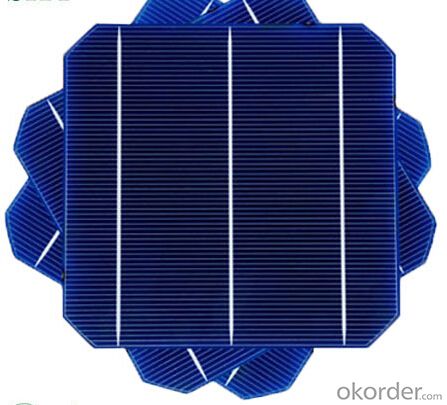
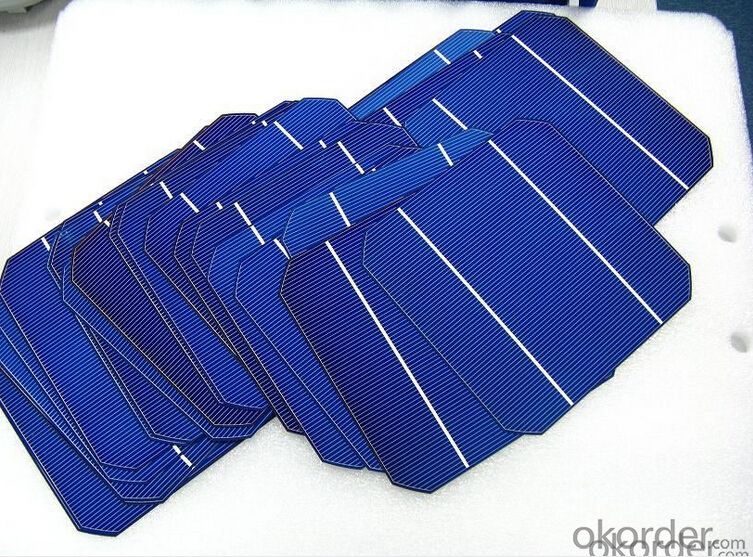
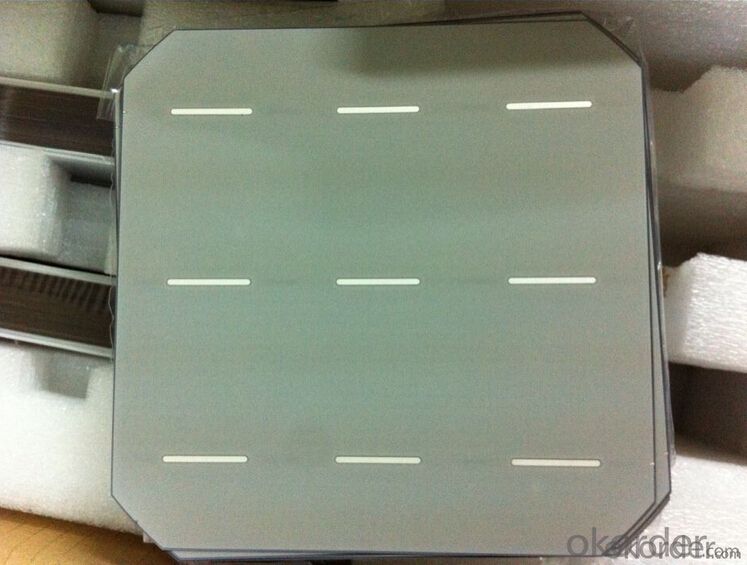
5.Packaging & Delivery of Poly Cells
Carton Box Package and Deliver by air. It should be noticed that it should be avoid water, sunshine and moist.
We have organized several common questions for our clients,may help you sincerely:
6.FAQ
1. What’s price per watt?
A: It’s depends on the quantity, delivery date and payment terms of the order. We can talk further about the detail price issue. Our products is high quality with lower price level.
2. Can you tell me the parameter of your solar cells?
We have different series of cells with different power output, both from c-si to a-si. Please take our specification sheet for your reference.
3. How do you pack your products?
We have rich experience on how to pack the panels to make sure the safety on shipment when it arrives at the destination.
4. Can you do OEM for us?
Yes, we can.
5. How long can we receive the product after purchase?
In the purchase of product within three working days, We will arrange the factory delivery as soon as possible. The perfect time of receiving is related to the state and position of customers. Commonly 7 to 10 working days can be served.
- Q: Are there any disadvantages to using solar panels?
- Yes, there are a few disadvantages to using solar panels. Firstly, the initial cost of installing solar panels can be quite high, although this cost has been decreasing in recent years. Additionally, the efficiency of solar panels can be affected by factors such as weather conditions and shading. Furthermore, solar panels require a significant amount of space for installation, which may not be feasible for everyone, especially in urban areas. Finally, solar panels are dependent on sunlight availability, making them less effective during cloudy or nighttime conditions.
- Q: i was looking into making solar panels to reduce my electric bill, but i need to know how to actually hook it up.
- nowing what to do with unused renewable electricity is always a dilemma – hooking up to the grid has to be the preferred option. If your residential home is grid tied, i.e. connected the electricity grid as opposed to off-grid and you are using solar panels to generate electricity. Then it makes a lot of sense to hook your solar panels to the grid, because instead of losing the unused electricity or having to maintain a bank of deep cycle batteries, you simply feed it back to the grid. You feed electricity back to the grid via your electric meter which measures the electricity in Kilowatt per hour. This has the effect of reversing your meter which in turn reduces your electricity bills and if you are generating a lot of electricity you could find the utility company owing you money! The Solar Powered System Therefore, your solar powered installation would look like this. The solar panel will connect to an “array disconnect” – you need an array disconnect for system maintenance because it allows you to easily shut off the power. The array disconnect is connected to an “inverter”. The solar panel generates DC power and the electricity from the grid is AC power. Therefore, you need an inverter to convert DC power to AC power. The inverter is connected to an “AC breaker panel”. This is the interface where your solar generated electricity meets the electric meter and allows you to feed electricity back to the grid. Now in most countries and states you are not allowed to tamper with the electric meter so at this point you should contact your local electricity energy supplier and ask them to supply an engineer to hook you up to the grid. If you have anything to add to this article or you have connected your system to the grid – tell us how you did it by writing a comment below.
- Q: So my buddy and I have an idea to start a small Solar Installation business. Small as in I am only willing to do one weekend a month and two weeks a year(I know it sounds like the reserves). These are my specific question:) What is the average cost in the U.S. to have Solar Panels installed?2) What is the average cost in the state of Hawaii to install Solar Panels?3)Is this a worth while venture? (There's a good chance i'm going to ignore this one anyways LOL!)4)How long does it take to install a photovoltaic solar panel?5)How long does it take to install a hot water solar panel?6)Besides the obvious, what permits are needed to get our start?7)What education or Cert. is needed?8)Average time to start up?If there is any other information you believe pertinent to this subject that I didn't ask directly, please share. Thank you for your help in advance!
- The North American Board of Certified Energy Practitioners (NABCEP) is the “gold standard” for PV and solar heating installation certification. Cost vary on the size and difficulty of the project. The price of the panels are dropping and technology is getting better. A rough rule of thumb estimate would be $3 per watt for all the hardware and then double that to cover labor and overhead (insurance, permits, gas for the truck etc) Solar thermal has a faster payback than PV. The panels themselves go up fairly quickly. Installing roof mount attachments can take some time. This is also one of the points of liability. If done improperly the roof may leak and cause more damage than the profits on that job could pay for. There are a number of kits and pre-bundled packages available. You might try installing one of those on a friendly first. Make it a weekend project for yourself or on a friend or relatives house.
- Q: Can solar panels be used in areas with high humidity?
- Yes, solar panels can be used in areas with high humidity. While high humidity may affect the efficiency of solar panels to some extent, they can still generate electricity. The performance of solar panels in humid environments can be optimized by using materials that are resistant to moisture and by ensuring proper installation and maintenance.
- Q: Are there any tax credits available for installing solar panels?
- Yes, there are tax credits available for installing solar panels. The federal government offers a Solar Investment Tax Credit (ITC) that allows homeowners and businesses to deduct a certain percentage of the cost of their solar panel system from their taxes.
- Q: Can solar panels be installed on a fire station or emergency services building?
- Yes, solar panels can be installed on fire stations or emergency services buildings. In fact, many fire stations and emergency services buildings have already adopted solar energy to reduce their carbon footprint and save on energy costs. The ample roof space available on these buildings makes them ideal candidates for solar panel installation. Additionally, the use of solar power can provide backup power during emergencies, ensuring uninterrupted services even during power outages.
- Q: I have 2 20 watt Solar panel. I have it hooked up to solar controller and batteries to inverter. Am trying to figure out how much watts am getting. I found the voltage but how do I find the amp reading on a mutimeter?
- It is possible your meter does not have the capacity to safely measure more than 300 milliamps which is too small to measure current output from solar panels. Assuming no losses in the system or components, if your meter does not have the capacity to measure 0 Amps, you will need to get one that does. Analogs are better than digitial for this. Most often the 0 Amp circuit of the meter has a discrete positive plug location for the positive test lead. Most have a common ground connection with the rest of the meter functions. If you are measuring current at the battery in the charge mode- Negative lead of meter goes to positive terminal of battery and positive lead of meter goes to the cable that was connected to the positive terminal of the battery. Since the Wattage is a nominal measurement, if you measure between the panel and controller, take measurement on one leg of the panel, as you want to measure the current with the loaded active circuit. Meter is oriented the same way as the measurement at the battery would be made above only this time the meter is between the panel and controller. At peak solar conditions, expect current to be measured at 2.5 to3 Amps or more per panel. Under optimal conditions your panel will have higher output than their ratings indicate. Open circuit can be close to 20 volts. Never short circuit the output of the solar panels. It is volts multiplied by amps that gives you Watts.
- Q: What makes them stop working after a while?
- You can search on solar panel failure mechanisms for scholarly works. Amorphous silicon thin-film panels go through an annealing, and power drops off after a couple years. This includes most of those flexible rubber mat type panels. That's why those are not used on serious installations. Serious panels intended for rooftop service generally come with a 25-year warranty, suggesting that the technology is more reliable than your washer, dryer, TV, computer, dishwasher, or water heater. One brand of panel had trouble about 0 years ago, but the manufacturer replaced all that were turned in, even paying shipping both ways. It was a problem with that particular model, not the technology. Our polysilicon panels have been on the roof for 3 years, now, and I've seen no sign of wear, yet, either electrically or mechanically.
- Q: I want to put a solar panel(s) on my roof. What components do I need besides the solar panels? solar power controller? wires? How do I hook it into my home's electrical system and about how much electricity could I generate and save? Would the panels pay for themselves over time? Any help will be appreciated. Thank you!
- The first thing that you have to realize is that solar panels only make DC currant. This is used to charge batteries which when hooked to an inverter will make 20 v. AC. You need a large bank of batteries and a heavy duty inverter to power your house. There is also an automatic switch that will send power back to the utility company when you have excess power available. This is not a small project. Really think this out before you invest a lot of money for nothing.
- Q: I want to replace my electricity with solar and wind. I live just right outside the city, the roof about 000 square feet. How many windmills/solar panels would it take to get me off the power grid?
- If you are in the desert and near the equator you will need fewer panels than if you live in a rain forest or Alaska. If you live in a wind tunnel with consistent strong wind, you will have better results than if you live where there often is a lull in the wind and changes of direction of the wind. If you already pump your water by hand, generate your own electricity by cycling using your legs, and go to bed whenever it gets dark out, you might make it. But if you tend to cook and launder on the grid, run a refrigerator, perhaps heat your house or air condition it, own various gadgets you plug into outlets to use, like lamps, puters, toaster, shaver, blender, dishwasher etc, you may not be able to get off the grid.
Send your message to us
Best Solar Panels in Texas:A Grade and B Grade 3BB and 4BB Solar Cells with High Efficiency 19.1%
- Loading Port:
- Shanghai
- Payment Terms:
- TT OR LC
- Min Order Qty:
- 10000 watt
- Supply Capability:
- 100000000 watt/month
OKorder Service Pledge
OKorder Financial Service
Similar products
Hot products
Hot Searches
Related keywords
